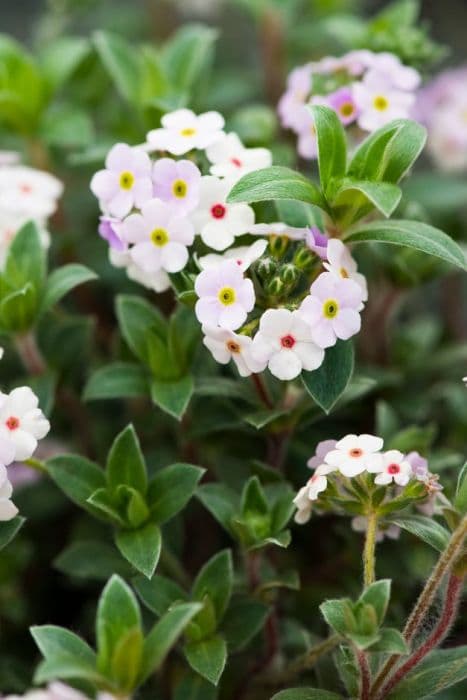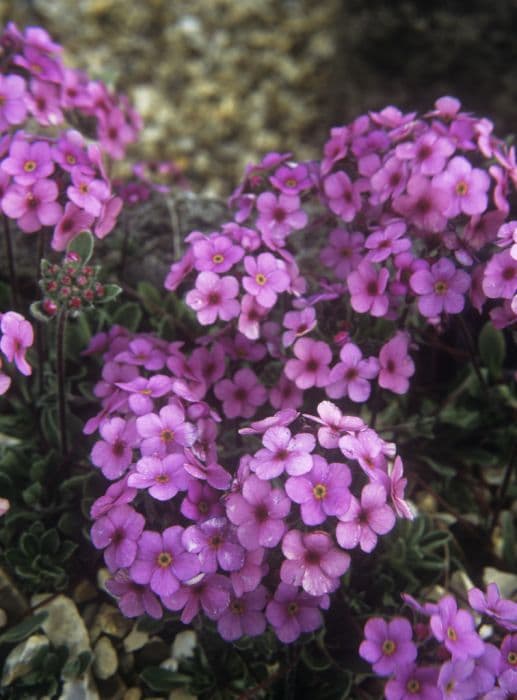Auricula Primula auricula 'Harry Hotspur' (Au/a)

ABOUT
The Primula auricula 'Harry Hotspur', often known as the Auricula or Bear's Ear, is a cultivar with strikingly beautiful and ornate features. This plant is renowned for its colorful rosettes of leaves that create a plush, textured base. The leaves are typically a lush green, occasionally with a powdery dusting that gives them a unique, frosted appearance. The most distinctive characteristic of Harry Hotspur is its blossoms. The flowers are formed in clusters that rise elegantly above the foliage on sturdy stems. Each individual flower is like a little work of art, comprised of rounded petals that encircle a golden, intricate eye. The petals boast a rich, velvety crimson that can sometimes look almost purple, an especially regal color that can add dramatic flair to any setting. The blooms are not only a feast for the eyes but also for the nose, emitting a delightful fragrance that is both sweet and inviting. Harry Hotspur offers a unique aesthetic appeal with its combination of vivid color and intoxicating scent, making it a cherished variety among garden enthusiasts.
About this plant
 Names
NamesFamily
Primulaceae.
Synonyms
Bear's Ear, Mountain Cowslip, Auricula.
Common names
Primula auricula 'Harry Hotspur'.
 Toxicity
ToxicityTo humans
The common name for Primula auricula 'Harry Hotspur' is Auricula. Generally, Auriculas contain compounds that can be mildly toxic to humans if ingested. The symptoms of poisoning can include nausea, vomiting, diarrhea, and skin irritation or dermatitis from handling the plants. It is advisable to avoid consuming any part of the plant.
To pets
The common name for Primula auricula 'Harry Hotspur' is Auricula. Auriculas may also be toxic to pets if ingested. Symptoms of poisoning in pets could involve gastrointestinal upset such as vomiting and diarrhea. In some cases, there could also be skin irritation or dermatitis if the pet comes into contact with the plant. Pet owners should prevent their animals from ingesting any part of the plant.
 Characteristics
CharacteristicsLife cycle
Perennials
Foliage type
Evergreen
Color of leaves
Green
Flower color
Red
Height
6 inches (15 cm)
Spread
6 inches (15 cm)
Plant type
Herb
Hardiness zones
5
Native area
Europe
Benefits
 General Benefits
General Benefits- Decorative Flowers: Primula auricula 'Harry Hotspur' boasts vibrant, eye-catching blooms that enhance the aesthetic appeal of gardens and landscapes.
- Extended Blooming Season: This variety often has a long flowering period, providing color from late winter to late spring.
- Compact Growth: Suitable for small gardens or container planting due to its compact size.
- Cold Hardy: It is resilient in cooler climates and can survive frost, making it a versatile plant for different garden zones.
- Low Maintenance: Requires minimal care once established, making it suitable for novice gardeners or those with limited time.
- Attracts Pollinators: The flowers can attract bees and butterflies, promoting biodiversity and aiding in the pollination of nearby plants.
- Versatility in Use: Can be planted in flower beds, rockeries, borders, and as part of alpine collections, giving gardeners multiple design options.
 Medical Properties
Medical PropertiesThis plant is not used for medical purposes.
 Air-purifying Qualities
Air-purifying QualitiesThis plant is not specifically known for air purifying qualities.
 Other Uses
Other Uses- Auricula Theatre Display: Enthusiasts of Auricula often use these plants to create a traditional "Auricula Theatre," which is a tiered showcase specially designed to display the unique beauty of the blooms.
- Photography Subject: The striking flower patterns and vibrant colors of Auricula make it an excellent subject for botanical photographers and artists.
- Educational Tool: Horticulture schools and courses may use Auricula as a specimen to teach students about plant breeding and hybridization techniques.
- Craft Inspiration: The diverse hues of Auricula can inspire color palettes for crafts like quilting, embroidery, or yarn dyeing.
- Garden Design: Auricula can be used to create intricate garden patterns or as a part of a rock garden, adding texture and color contrast.
- Wedding Decorations: Auricula flowers can be incorporated into wedding bouquets or table centerpieces for a unique, vintage look.
- Floral Arrangements: Although not commonly used this way, the distinctive look of Auricula flowers can add an exotic touch to cut floral arrangements.
- Culinary Garnish: The edible blooms of Auricula can be used to garnish desserts or cocktails, although this is not a traditional use.
- Color Dye: Historically, some species of Primula have been used to create natural dyes; crafters might explore Auricula's potential in this context.
- Collectors' Item: The immense variety of Auricula, including 'Harry Hotspur', makes them a prized collector's item for gardeners specializing in rare and unusual plants.
Interesting Facts
 Feng Shui
Feng ShuiThe Auricula is not used in Feng Shui practice.
 Zodiac Sign Compitability
Zodiac Sign CompitabilityThe Auricula is not used in astrology practice.
 Plant Symbolism
Plant Symbolism- Delicacy: The Primula auricula, commonly known as Auricula, often symbolizes delicacy due to its intricate and delicate flower structure.
- Pride: Primula auricula has a meaning of pride because of the way it stands tall and presents its blooms.
- Diverse Beauty: The variety of colors in Auriculas, including 'Harry Hotspur', represent the beauty of diversity and the wide range of appearances in nature.
- Precision and Care: Auriculas are known for their specific cultivation requirements, reflecting the need for precision and attentive care in gardening.
- The Magic of Spring: As a spring-blooming flower, the Auricula is symbolic of the rejuvenation and magical transformation that comes with the season.
 Water
WaterAuricula 'Harry Hotspur' prefers to be kept evenly moist, but not soggy. Water this plant once a week with about 16 ounces of water, ensuring that the soil is damp but allowing the top inch of soil to dry out before watering again. Over the course of a month, you should be watering approximately 4 times, totaling about 64 ounces of water. Always avoid wetting the foliage to prevent disease, and use room temperature water to avoid shocking the plant's roots.
 Light
LightAuriculas like 'Harry Hotspur' thrive best in bright, indirect light. They should be positioned where they receive morning sun and afternoon shade to protect them from the intense heat of the day. An east-facing windowsill or a spot that gets dappled light throughout the day is ideal for these plants.
 Temperature
TemperatureAuricula 'Harry Hotspur' prefers cooler temperatures, ideally between 50°F and 70°F. The plant can survive temporary drops down to 40°F but prolonged exposure to temperatures below this can be damaging. Similarly, temperatures above 80°F may stress the plant, so it's essential to maintain a moderate and consistent temperature range.
 Pruning
PruningAuricula 'Harry Hotspur' should be pruned to remove dead or fading flowers and to shape the plant, which typically occurs post-blooming in late spring or early summer. Pruning encourages healthier foliage and stimulates new growth. Gentle pruning can be done as needed throughout the year to remove any brown or damaged leaves.
 Cleaning
CleaningAs needed
 Soil
SoilAuricula primroses like a well-draining, slightly alkaline soil mix with a pH of 6.5-7.5. A suitable mix could be composed of one part loam, one part grit or perlite, and one part leaf mold or well-rotted compost. This combination provides the necessary drainage and nutrient content for healthy growth.
 Repotting
RepottingAuricula primroses should be repotted annually, best done in late summer after flowering. This frequency ensures fresh soil nutrients and prevents the plant from becoming root-bound, which can negatively affect its health and blooming.
 Humidity & Misting
Humidity & MistingAuricula primroses prefer moderate humidity levels and do not thrive in overly dry or excessively humid environments. Aim for a relative humidity level of about 50-60% for optimal plant health.
 Suitable locations
Suitable locationsIndoor
Place in bright, indirect light with cool temperatures.
Outdoor
Partial shade, sheltered from harsh elements.
Hardiness zone
4-8 USDA
 Life cycle
Life cyclePrimula auricula 'Harry Hotspur', also known as Auricula or Bear's Ear, begins its life cycle when the seeds are sown in well-draining soil, usually in late winter or early spring. After germination, seedlings emerge and gradually develop a rosette of leaves at the soil surface. The plant enters a vegetative stage, where it focuses on leaf growth, and with proper care, it matures over several months. Once mature, it produces tall flowering stems in spring, which bear clusters of ornate, colorful flowers, characteristic of the 'Harry Hotspur' variety. After pollination, which can be aided by insects, the flowers develop into seed capsules; when the seeds mature, they are released to start a new life cycle. Outside of its active growing and blooming phase, the Auricula enters a period of dormancy, typically in the winter months, to conserve energy for the next growing season.
 Propogation
PropogationPropogation time
Spring-Early Summer
Primula auricula 'Harry Hotspur', commonly known as Auricula, can be propagated through division, which is the most popular method. This is best done immediately after the plant has finished blooming in late spring to early summer. Carefully lift the clump from the soil and gently tease apart the offsets, which are the smaller, secondary plants at the base of the main plant. Each offset should have a portion of roots attached. Replant these offsets immediately, at the same depth they were growing before, and water them well. They should be spaced about 6 to 12 inches (15 to 30 centimeters) apart to provide enough room for growth. With proper care, these divisions will establish themselves and grow into new, healthy plants.









